Aquaponics: An Emerging Method for Food Sustainability
Written by: Erin Yoo
In the United States alone, seventeen million families cannot afford to put food on the table each day (Pont, 2021). In fact, food security is a global problem that is becoming a bigger threat to human health and sustainable living every day. Luckily, researchers and entrepreneurs have been experimenting with new, innovative agricultural systems that could provide sustainable food security. Once such method is known as aquaponics. Although modern aquaponics stems from the late 1970s and 1980s — credits to researchers at the New Alchemy Institute of North Carolina State University, it has actually been in use for thousands of years (Goddek 2015). For example, the chinampas (or floating gardens) used by the Aztecs could be considered aquaponics due to its fusion of plant agriculture and water ecosystems. Today, the ancient agricultural practice has the potential to provide sustainable food and living.
The Advantages of Aquaponics
The name “aquaponics” comes from the fact that it’s a combination of hydroponics (plant cultivation without the use of soil) and aquaculture (fish cultivation). Its largest appeal comes from its lack of waste and required maintenance — a huge plus for sustainability and eco-friendliness. Put simply, aquaponics is a mini-ecosystem where fish emissions like gill excretions, urine, and feces are used as fertilizer for harvesting and growing plant crops (Goddek 2015). The plants, in turn, absorb the nutrients from the water and return clean water to the fish through a connected pipe system (Goddek 2015; “What is Aquaponics?” n.d.). In fact, about 95-99% of water is reused in aquaponics systems (Goddek 2015). This constant recycling and reuse of water is a significant advantage that hydroponics has over aquaculture, where water has to be discarded everyday due to toxic ammonia buildup (Goddek 2015; “What is Aquaponics?” n.d.).
Figure 1
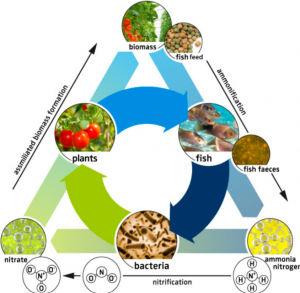
The cycle of aquaponics
Source: MDPI
Another advantage aquaponics has over hydroponics is its efficient maintenance process. Hydroponics requires the careful and intricate maintenance of plants where farmers must concoct detailed mixes of man-made chemicals and nutrients (“What is Aquaponics?” n.d.). On the other hand, aquaponics farmers only have to monitor nutrient concentrations and adjust them as needed since the fish provide all the nutrients to begin with (Goddek 2015). In fact, all that is needed to take care of an aquaponics ecosystem is food scraps or fish feed. Afterward, the fish take care of the rest.
Hydroponics also requires lots of energy to produce and transport nutrients for plants, resulting in the pollution of surface and groundwater. Since nutrients are already provided for plants in aquaponics systems by the system itself, aquaponics reduces pollution in addition to limiting resource use (Goddek 2015).
The Setup
Further, anyone can implement this in their home and or backyard. For instance, some systems are small enough to fit on a kitchen table, like the SpringWorks Microfarm System and AquaSprouts Aquarium Garden sold by The Aquaponic Source (see Figure 2). Others are large and industrial, like the one maintained at the University of the Virgin Islands (see Figure 3). Still others are elongated vertical structures resembling a new, modern tree seen in sci-fi movies (see Figure 4).
Though the range of aquaponics setups is diverse, all systems share the main components of a water trough, where plants’ roots are submerged in nutrient water; fish tanks, which supply the nutrient water; pipes, which connect the tanks and create a water flow system; and filters between the tanks. These components act like modules which can be arranged and rearranged to form simple or complex setups depending on the farmer(s) specific wants and needs, allowing for an easy and efficient setup.
Figure 2
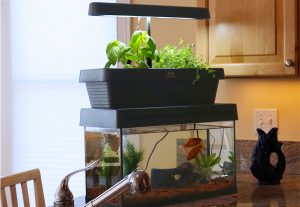
SpringWorks Microfarm System
Source: The Aquaponic Source
Figure 3
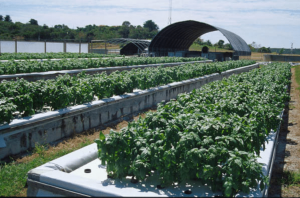
Basil crops at the UVI aquaponics system
Source: Donald S. Bailey at ResearchGate
Figure 4
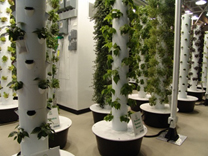
Vertical aquaponics system cultivating vine plants
Source: AgMRC.org
The Long-Term Sustainability of Aquaponics
Efficient nutrient recycling, water reuse, and limited required resources for upkeep mean that aquaponics can be quite sustainable. For example, around the world, about 70% of freshwater is used up by conventional soil agriculture (Goddek 2015). In some areas where water can be especially scarce, like North Africa or the Middle East, the percentage rises to 90%. In contrast, aquaponics agriculture is estimated to use less than 10% of available freshwater (Goddek 2015). Thus, implementing aquaponics systems would free up enormous volumes of water for communities where water is scarce.
Aquaponics is also an easily adaptable system that can be implemented in a variety of environments. From old, neglected warehouses to stylish urban roof gardens (see Figure 5), aquaponics setups do not require deforesting hundreds of acres as conventional agriculture does (Goddek 2015). In effect, they save space on top of reducing resource consumption and pollution. Implementing aquaponics into urban living also reduces carbon emissions, energy, and cost use by bringing food closer to its consumers. A shorter distance between food production and consumption means less energy, cost, labor, and resources are required to package, transport, and deliver food (Goddek 2015). In other words, aquaponics can shorten and simplify food supply chains which is more eco-friendly.
Figure 5
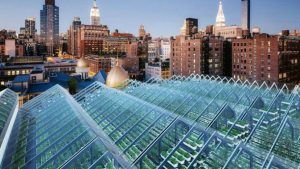
An urban rooftop aquaponics system
Source: Inhabit.com
Conclusion
Despite all of its advantages, aquaponics hasn’t driven a huge revolution in agriculture or food supply industries yet because there isn’t much literature or research on its long-term effects. More experimentation and research has to be done to create, organize, and market ideal aquaponics setups for large-scale sustainable food production. For now, though this is just a start, aquaponics seems promising due to its numerous environmental and sustainability benefits. With aquaponics, communities could take a step towards stronger food security and a more sustainable future.
References and Sources
“Aquaponics.” USDA National Agricultural Library, https://www.nal.usda.gov/afsic/aquaponics, accessed 12 Oct. 2021.
“Aquaponics at Home.” The Aquaponic Source, https://www.theaquaponicsource.com/home-aquaponics-system/, accessed 12 Oct. 2021.
Burden, Dan, and Pattillo, D. Allen. “Aquaponics.”AgMRC, https://www.agmrc.org/commodities-products/aquaculture/aquaponics, accessed 12 Oct. 2021.
Goddek, Simon, et al. “Challenges of Sustainable and Commercial Aquaponics.” Sustainability, vol. 7, no. 4, 2015, pp. 4199-4224. MDPI, doi.org/10.3390/su7044199.
Pont, Cassidy. “Building Back Better for Child Nutrition.” Save the Children Action Network, 4 Mar. 2021, https://savethechildrenactionnetwork.org/blog/building-back-better-for-child-nutrition/.
“What is Aquaponics?” The Aquaponic Source, https://www.theaquaponicsource.com/what-is-aquaponics/, accessed 12 Oct. 2021.
1 thoughts on “Aquaponics: An Emerging Method for Food Sustainability”